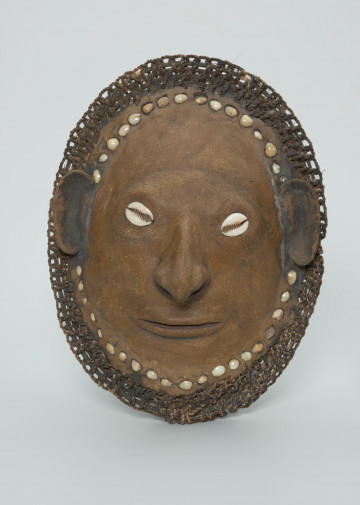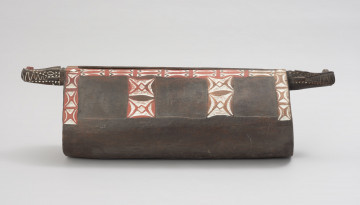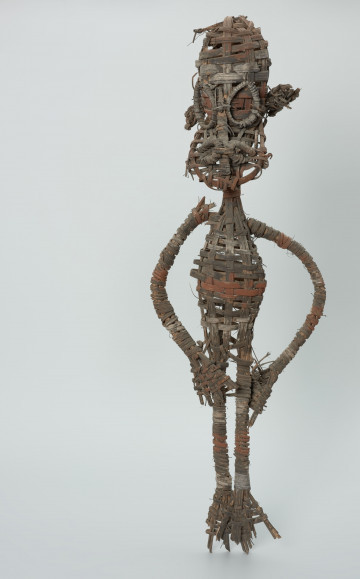
Tortoise-shell mask of ancestor
około 1980 — 1985
National Museum in Szczecin
Part of the collection: Art of Papua New Guinea
This ceremonial flute was made from a bamboo piece opened on the side used for blowing and closed with a natural knee on the opposite side, where there is a figure of a female ancestor with a bird on her head carved in a kneeling position. The patterns visible on the surface were created by scraping off the top layer of fresh bamboo, into which vegetable dyes were rubbed. After they dried, the brown colour remained, distinguishable from the unpainted parts. Flutes and the music played on them used to be strongly associated with the supernatural world, fertility and initiation rituals. They were considered to be powerful magical objects filled with power. They were used to imitate the voices of ancestral spirits. They were wrapped in mats and kept in temples, called Spirit Houses, inaccessible to women and uninitiated people. The flute sound was a warning signal against the spirits that were summoned on the occasion of the initiation ritual of young men. It commanded all those who could not witness the ritual to hide. In New Guinea, every young man had to undergo initiation. Depending on the region, this ritual varied in form and the severity of the trials. In the villages of the Iatmuli and Sawos, the initiation, often preceded by the adepts' long fast, took place inside the House of the Spirits. It culminated in the incision of the skin in the pattern of crocodile scales. The boy sat on a stool, symbolising the Ancestor of the community. The Ancestor of the Forefather decided whether the boy had passed the test of pain and whether he would join the group of initiated men. Deaths occurred during the initiation. To honour the dead boys, openwork malu shields with images of human faces surrounded by birds were made to symbolise their souls and kept in the Spirit Houses.
Katarzyna Findlik-Gawron
Author / creator
Dimensions
cały obiekt: height: 129 cm, width: 13,3 cm
Object type
flute
Creation time / dating
Creation / finding place
Identification number
Location / status

około 1980 — 1985
National Museum in Szczecin

1841 — 1860
National Museum in Szczecin

1951 — 1995
National Museum in Szczecin
DISCOVER this TOPIC
National Museum in Lublin
DISCOVER this PATH
Educational path